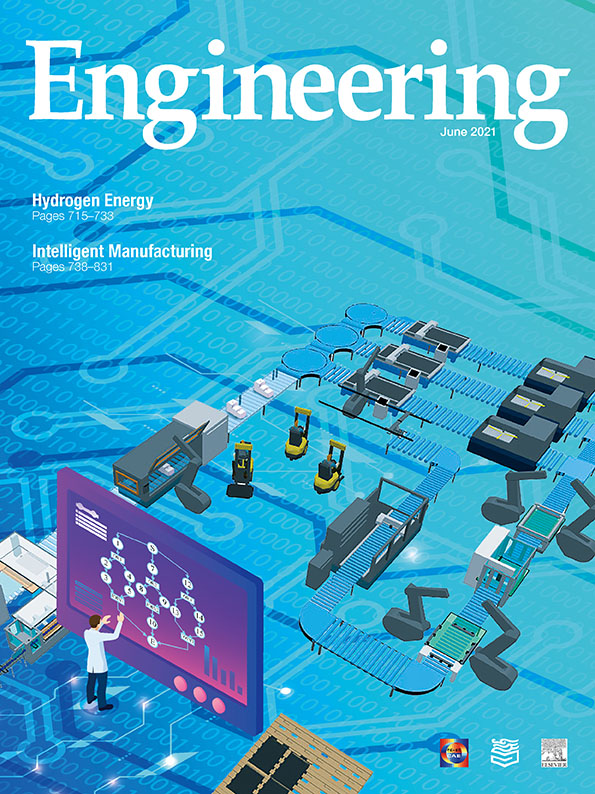Intelligent manufacturing is the development trend of manufacturing industries. It comprises the deep integration of new-generation information and communication technologies (i.e., fifth generation mobile networks (5G), artificial intelligence, the Industrial Internet, etc.) with advanced manufacturing technologies, covering the whole life cycle of a product, including design, production, logistics, services, and so forth. Although it is largely based on automation and machine intelligence, humans play essential roles in intelligent manufacturing.
This special issue of Engineering is a collection of recent achievements in intelligent manufacturing research that hold potential to significantly promote the development of this field. The issue contains eight papers—one opinion paper and seven research papers—contributed by influential experts in the field from China, the United States, Germany, New Zealand, Sweden, the Republic of Korea, Canada, and the United Kingdom. These papers illustrate the state of the art of intelligent manufacturing in the following areas:
《1. Key issues in intelligent manufacturing》
1. Key issues in intelligent manufacturing
Three key issues in intelligent manufacturing are presented in this special issue. The first issue is the comparison between smart manufacturing and intelligent manufacturing, which have been widely used to describe a similar paradigm by some researchers. However, Wang et al. consider that they are not identical. They perform a comparative literature review on inherent differences of smart manufacturing and intelligent manufacturing and clarify their relationship and future development. The second issue is how to consider the human factor in intelligent manufacturing. In their opinion paper, Lu et al. present a futureproofing human– machine symbiosis framework that features human centrality, social wellness, and adaptability. In their research paper, Gu et al. propose a gaze estimation method via a differential eyes’ appearances network with a reference grid to enable an artificial intelligence system to analyze a person’s intentions. This technology can be used in many fields of intelligent manufacturing, including human–robot collaboration and virtual reality. The third issue addressed in this special issue is how to use 5G networks in intelligent manufacturing. In their research paper, Shi et al. describe a multilayer collaboration framework enabled by vehicle-to-everything communications for logistics management in industrial parks. This technology can assist in enabling 5G application in all aspects of intelligent manufacturing.
《2. Typical applications of intelligent manufacturing technologies》
2. Typical applications of intelligent manufacturing technologies
Intelligent manufacturing technologies exist in all aspects of manufacturing. In the design phase, an increasing number of customers can participate in product design. However, giving access to more people introduces greater security threats to cloud manufacturing. In their research paper, Yang et al. propose a novel attribute-based encryption approach for computer-aided design (CAD) assembly models that can effectively support hierarchical access control, integrity verification, and deformation protection for co-design scenarios in cloud manufacturing. This approach can help to solve information security threats in public clouds.
Process planning is a bridge between product design and practical manufacturing that directly affects the quality and efficiency of the product. In their research paper, Liu et al. propose a novel mixed-integer linear programming (MILP) mathematical model by considering the network topology structure and the OR nodes that represent a type of OR logic inside the network. This work can also be expanded to integrate process planning with scheduling—another important component in intelligent manufacturing systems.
Machine vision is an essential technique in intelligent manufacturing and is widespread in many phases of manufacturing, including monitoring and detection. In their research paper, Fahimipirehgalin et al. present a method based on infrared video data and machine vision techniques to detect and localize liquid leakages in a chemical process plant. This method can reduce the maintenance cost of the plant and decrease the incidence of unsafe and hazardous situations for the operators.
A solution to the difficult problem of how to effectively deal with random arrivals of diverse customer requirements is urgently needed in intelligent manufacturing. In their research paper, Zhou et al. propose unified theoretical models and simulation models of different production strategies—including time-triggered strategies, event-triggered strategies, and hybrid-triggered strategies—to enable manufacturing enterprises to satisfy randomly arriving orders and reduce inventory costs. This method can help an enterprise maintain a high level of competitiveness in a dynamic environment.
Deeply inspired by the impressive work presented in this special issue, we are grateful to all the authors for their contributions. However, the works in this issue also reveal that few mature solutions are available for key issues in intelligent manufacturing. In the process of promoting intelligent manufacturing, many unsolved problems remain to be solved by researchers and engineers.













 京公网安备 11010502051620号
京公网安备 11010502051620号




